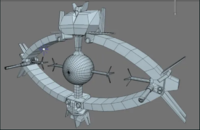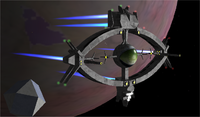Difference between revisions of "OXP howto texture"
Cholmondely (talk | contribs) (→External Links: Added another) |
Cholmondely (talk | contribs) (Added pictures at top) |
||
| Line 1: | Line 1: | ||
| + | [[File:Untextured Odyssey.png|thumb|right|200px|Maaarcooose's finished model of the Odyssey, prior to texturing]] |
||
| + | [[File:U31 odyssey.png|thumb|right|200px|Textured Odyssey]] |
||
Note that possibilities have increased immensely since this was written in 2006-13. See [http://aegidian.org/bb/viewtopic.php?f=2&t=19881 A Description of the Improved Lighting and Materials System] (2018-21) for details. |
Note that possibilities have increased immensely since this was written in 2006-13. See [http://aegidian.org/bb/viewtopic.php?f=2&t=19881 A Description of the Improved Lighting and Materials System] (2018-21) for details. |
||
Revision as of 18:10, 18 November 2021
Note that possibilities have increased immensely since this was written in 2006-13. See A Description of the Improved Lighting and Materials System (2018-21) for details.
Contents
Step 1
Open a good graphic editing application, something a bit more elaborate than MS-paint.
Gsagostinho (2017): I think I am addicted to Wings3D, learned how to use it in just a few days after banging my head against Blender's wall for years.
Custom texture native models
You can create custom textures for any Oolite native entities, the steps to follow are:
- Edit the chosen native texture to your own liking.
- Duplicate the chosen Xnative_ship.dat model, and alter the file name. Open the copy in a text editor, and change all referances from Xnative_ship.png to the name of your custom_texture.png.
- Create a custom shipdata.plist, with a like_ship entry which refers to the original, and place your components into the appropriate folders, making a complete, funcional OXP.
Textures from a wings3D model
After you have created a model, you need to apply an UV-Map, this defines the way your future texture-file will be stretched accross your model. Use hard edges to mark where to 'cut' the textures.
There are two ways Wings-3D will extract an UV-Map:
(1) Fold: like a papermodel, the model is folded out to the flat plane of the texture. Can be usefull for small details, but may be difficult to line up correctly.
(2) Projection: the less complicated approach, will project (average normal) the sections unto the texture canvas.
Move around the sections untill you are satisfied. Then create a texturemap from the UV-Map, do not forget to set 'draw all lines' in the options. Repeat this for all UV's the model uses. Close the UV-window and rename the texture file in the 'outliner'. Export the file. (note: win-wings does not support PNG-format, use BMP)
You may want to look at Daniel Walker's texture guide.
Beginners and non-2D-artists may prefer to begin here, instead.
Step2
Now edit the file in your graphic software.
When you are satisfied with your results, save and go back to wings3D. Most probably you have saved under a new filename, so 'import-image' it. Now drag the edited texture to it's corresponding UV-Map. Your texture should now appear on the model (place some light sources first). Check if all the various parts line up correctly.
Edit the texture some more if you are not impressed with your results, save under the same name and in wings3D select 'refresh' image in the outliner.
Export model
Before you export, make sure the texture images are 'internal'. Export in *.dat-format.
win-wings users:
- Export in *.obj + *.mtl.
- Rename the texture references in the mtl-file from *.bmp to *.png)
- Open texturefiles and save as *.png.
- Convert the obj+mtl files to *.dat format via Obj2DatTexNorm.py.
Internal Links
- OXP
- OXP howto
- OXP howto model
- Smivs'_texture_tutorial
- Texturing tips and tricks by Theta Seven
- Oolite Converters
External Links
- Wings3D official home
- Tuts and tips Wings3D, by Aardvark
- YouTube classes in Wings3D (2013-4) by Dertien
- Putting it all together (2018) by Phkb
- Lighting & Materials tips for the newer versions of Oolite (2020) by Another_commander

